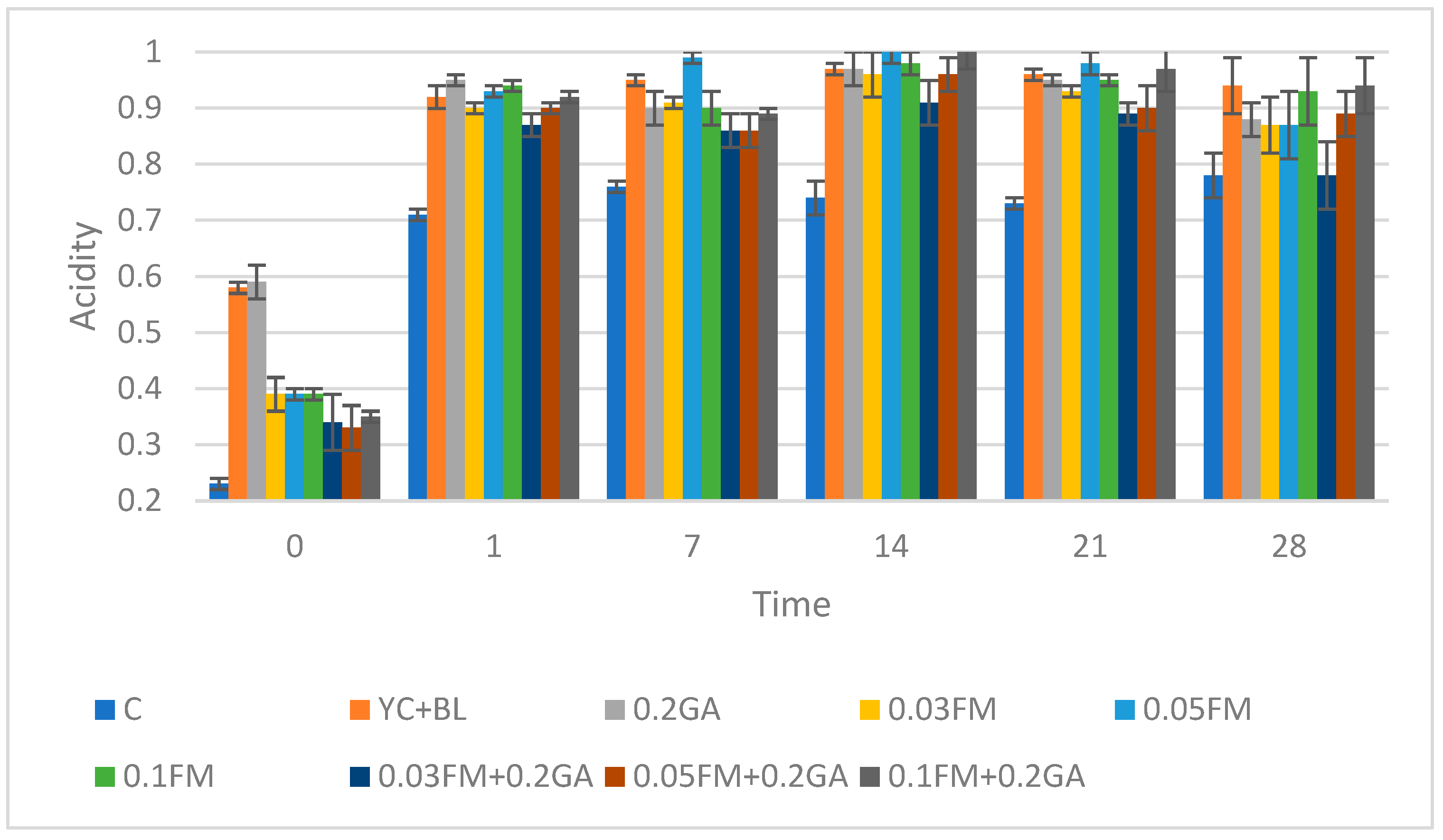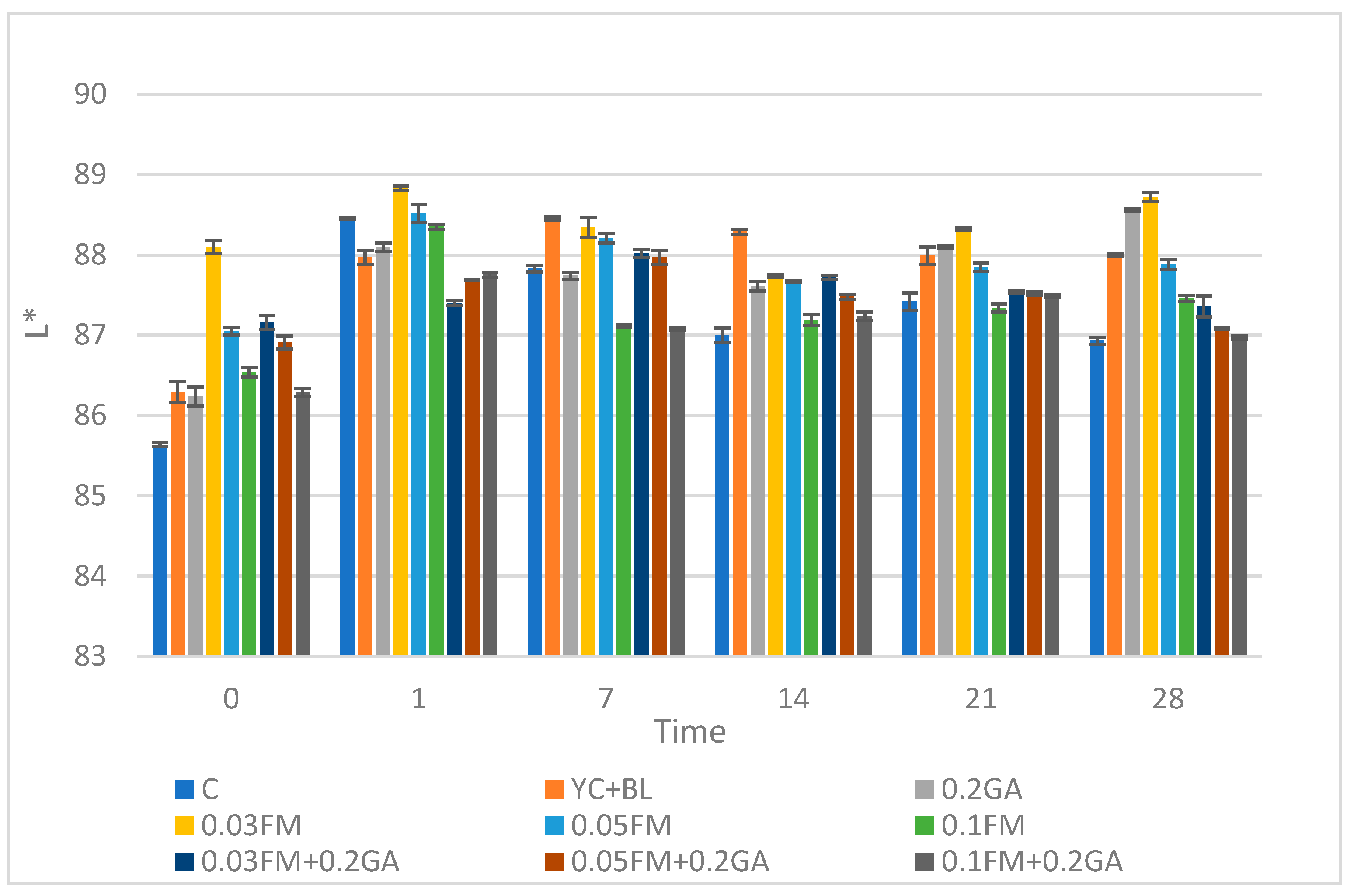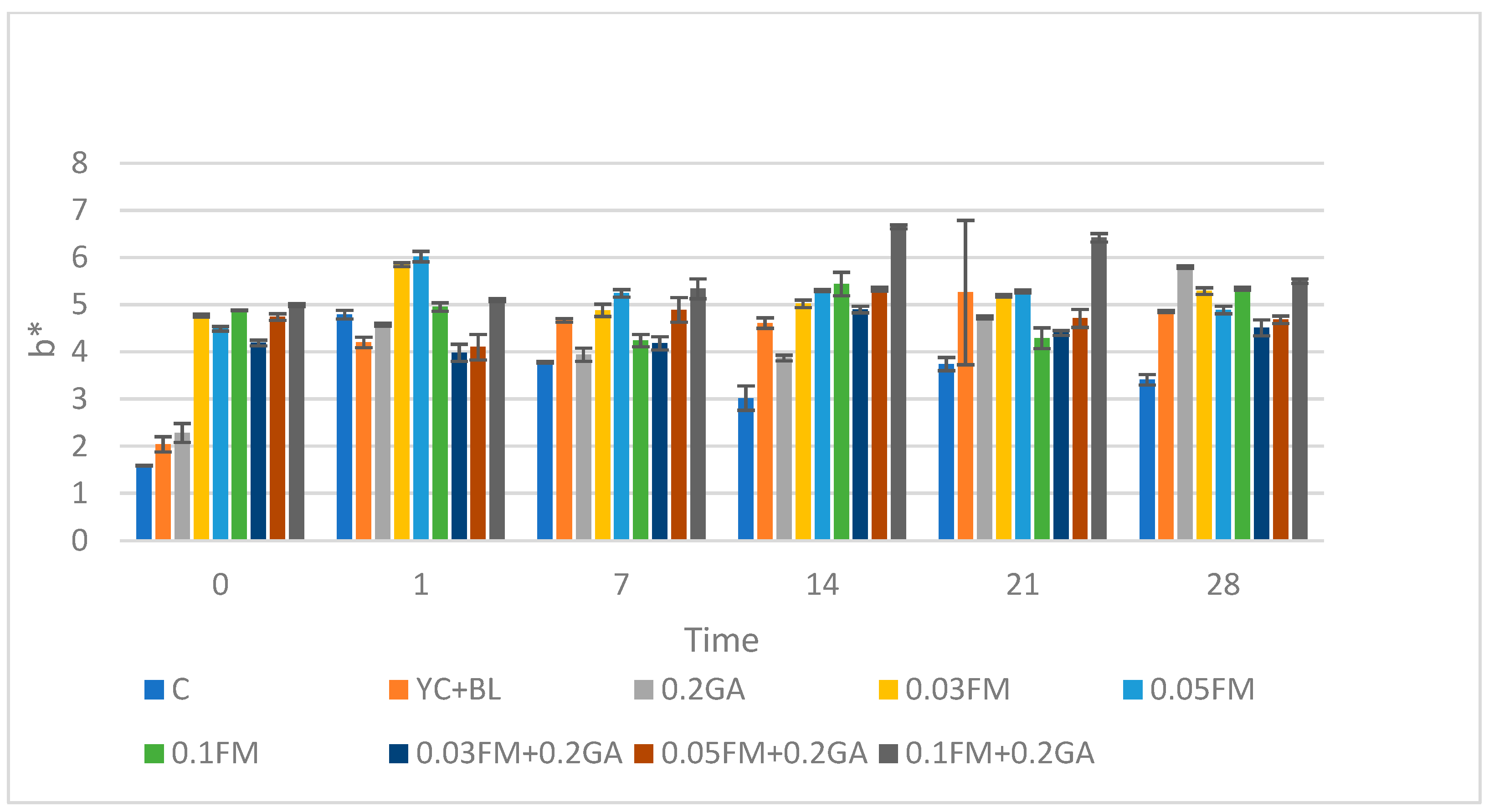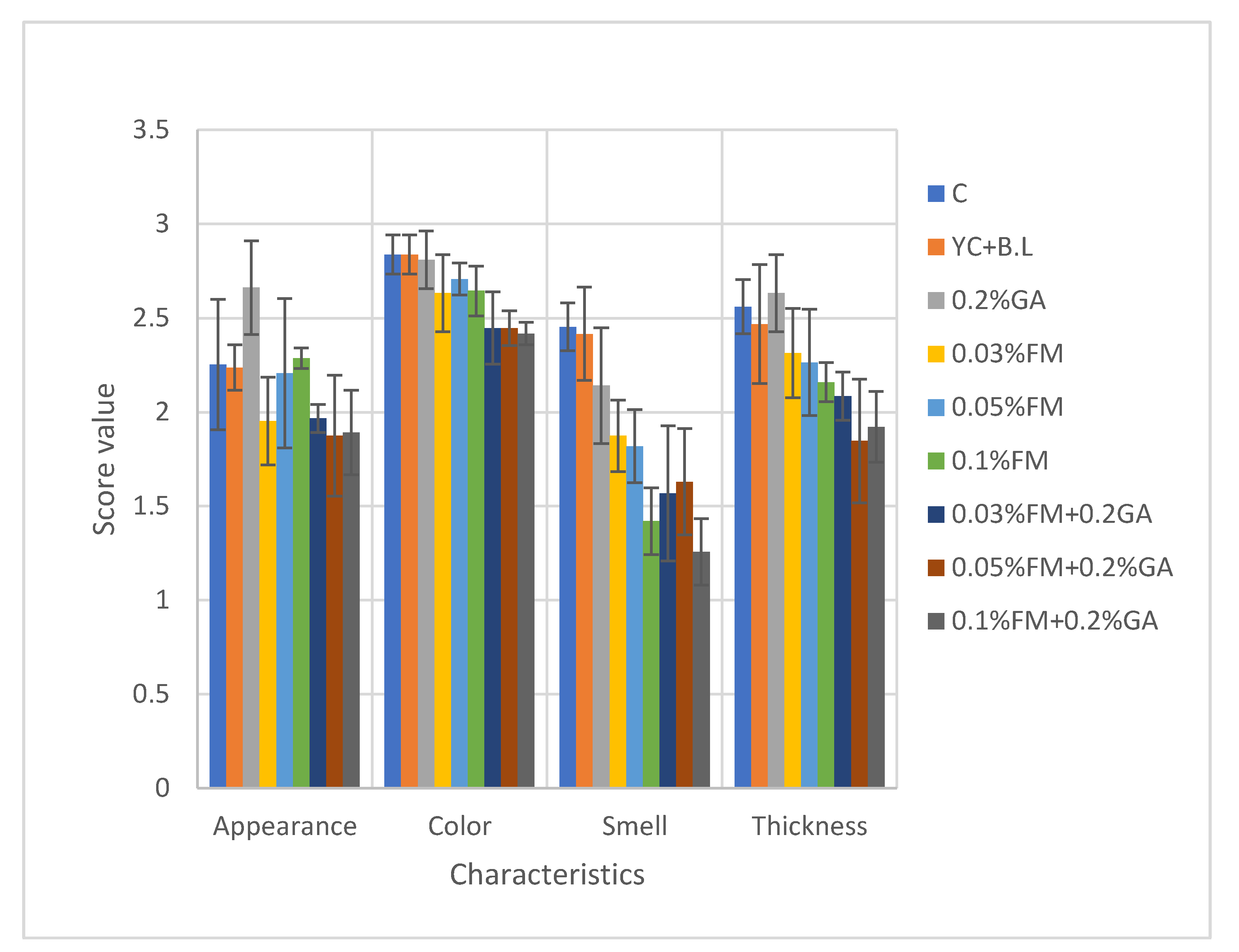Effect of Flaxseed Mucilage and Gum Arabic on Probiotic Survival and Quality of Kefir during Cold Storage
Abstract
1. Introduction
2. Materials and Methods
2.1. Extraction of Flaxseed Mucilage
2.2. Experimental Design
2.3. pH and Acidity
2.4. Viscosity
2.5. Color
2.6. Microbial Analysis
2.7. Total Solid and Protein Analysis
2.8. Sensory Analysis
2.9. Statistical Analysis
3. Results and Discussion
3.1. Viability of Lactobacillus acidophilus
3.2. Growth of Bifidobacterium lactis
3.3. pH Value
3.4. Acidity
3.5. The Viscosity
3.6. Color Parameters (L*, a* and b*)
3.7. Total Solid and Protein Measurements
3.8. Sensory Analysis
4. Conclusions
Author Contributions
Funding
Data Availability Statement
Conflicts of Interest
References and Notes
- Jalali, F.; Sharifi, M.; Salehi, R. Kefir induces apoptosis and inhibits cell proliferation in human acute erythroleukemia. Med. Oncol. 2016, 33, 7. [Google Scholar] [CrossRef] [PubMed]
- Baschali, A.; Tsakalidou, E.; Kyriacou, A.; Karavasiloglou, N.; Matalas, A.L. Traditional low-alcoholic and non-alcoholic fermented beverages consumed in European countries: A neglected food group. Nutrtion Res. Rev. 2017, 30, 1–24. [Google Scholar] [CrossRef] [PubMed]
- Rosa, D.D.; Dias, M.M.; Grześkowiak, Ł.M.; Reis, S.A.; Conceiço, L.L.; Peluzio, M.C.G. Milk kefir: Nutritional, microbiological and health benefits. Nutr. Res. Rev. 2017, 30, 82–96. [Google Scholar] [CrossRef] [PubMed]
- Renner, E.; Renz-Schaven, A. Nahrwerttabellen für Milch und Milchprodukte; Verlag B. Renner. Köhner K. G.: Gieben, Germany, 1986. [Google Scholar]
- Seo, M.K.; Park, E.J.; Ko, S.Y.; Choi, E.W.; Kim, S. Therapeutic effects of kefir grain Lactobacillus-derived extracellular vesicles in mice with 2, 4, 6-trinitrobenzene sulfonic acid-induced inflammatory bowel disease. J. Dairy Sci. 2018, 101, 8662–8671. [Google Scholar] [CrossRef] [PubMed]
- Leite, A.M.O.; Miguel, M.A.L.; Peixoto, R.S.; Rosado, A.S.; Silva, J.T.; Paschoalin, V.M.F. Microbiological, technological and therapeutic properties of kefir: A natural probiotic beverage. Braz. J. Microbiol. 2013, 44, 341–349. [Google Scholar] [CrossRef]
- Daun, J.K.; Barthet, V.J.; Chornick, T.L.; Duguid, S. Structure, composition, and variety development of flaxseed. In Flaxseed in Human Nutrition; Thompson, L.U., Cunnane, S.C., Eds.; AOCS Press: Champaign, IL, USA, 2003; pp. 1–40. [Google Scholar]
- El-Beltagi, H.S.; Salama, Z.A.; El-Hariri, D.M. Evaluation of fatty acids profile and the content of some secondary metabolites in seeds of different flax cultivars (Linum usitatissimum L.). Gen. Appl. Plant Physiol. 2007, 33, 187–202. [Google Scholar]
- Kajla, P.; Sharma, A.; Sood, D.R. Flaxseed—a potential functional food source. J. Food Technol. 2015, 52, 1857–1871. [Google Scholar] [CrossRef]
- Liu, J.; Shim, Y.Y.; Shen, J.; Wang, Y.; Ghosh, S.; Reaney, M.J.T. Variation of composition and functional properties of gum from six Canadian flaxseed (Linum usitatissimum L.) cultivars. Int. J. Food Sci. Technol. 2016, 51, 2313–2326. [Google Scholar] [CrossRef]
- Singer, F.A.W.; Taha, F.S.; Mohammad, S.S.; Gibriel, A.; El-Nawaway, M. Preparation of mucilage/protein products from flaxseed. Am. J. Food Technol. 2011, 6, 260–278. [Google Scholar] [CrossRef]
- Williams, P.A.; Phillips, G.O. Gum arabic. In Handbook of Hydrocolloids; Phillips, G.O., Williams, P.A., Eds.; CRC Press: Boca Raton, FL, USA, 2000; pp. 155–168. [Google Scholar]
- Sadek, Z.; El-Shafei, K.; Murad, H.A. Utilization of xanthan gum and inulin as prebiotics for lactic acid bacteria. In: 9th Egyptian conference for dairy science and technology, Cairo, Egypt. Egypt. Soc. Dairy Sci. 2006, 102, 269–283. [Google Scholar]
- Ghasempour, Z.; Alizadeh, M.; Rezazad Bari, M.R. Optimization of probiotic yogurt production containing Zedo gum. Int. J. Dairy Technol. 2012, 65, 118–125. [Google Scholar] [CrossRef]
- Yilmaz-Ersan, L.; Ozcan, T.; Akpinar-Bayizit, A. Impact of some gums on the growth and activity of Bifidobacterium Animalis subsp. lactis. Int. J. Food Eng. 2017, 3, 73–77. [Google Scholar] [CrossRef]
- Sabooni, P.; Pourahmad, R.; Mahdavi Adeli, H.R. Improvement of viability of probiotic bacteria, organoleptic qualities and physical characteristics in kefir using transglutaminase and xanthan. Acta Sci. Pol. Technol. Aliment. 2018, 17, 141–148. [Google Scholar] [CrossRef] [PubMed]
- Gibson, G.R.; Roberfroid, M.B. Dietary modulation of the human colonic microbiota: Introducing the concept of prebiotics. J. Nutr. 1995, 125, 1401–1412. [Google Scholar] [CrossRef] [PubMed]
- Fazio, A.; La Torre, C.; Caroleo, M.C.; Caputo, P.; Cannataro, R.; Plastina, P.; Cione, E. Effect of Addition of Pectins from Jujubes (Ziziphus jujuba Mill.) on Vitamin C Production During Heterolactic Fermentation. Molecules 2020, 25, 2706. [Google Scholar] [CrossRef]
- Znamirowska, a.; Szajnar, K.; Pawlos, M. Effect of Vitamin C Source on Its Stability during Storage and the Properties of Milk Fermented by Lactobacillus rhamnosus. Molecules 2021, 26, 6187. [Google Scholar] [CrossRef] [PubMed]
- Basiri, S.; Haidary, N.; Shekarforoush, S.S.; Niakousari, M. Flaxseed mucilage: A natural stabilizer in stirred yogurt. Carbohydr. Polym. J. 2018, 187, 59–65. [Google Scholar] [CrossRef] [PubMed]
- Mousavi, M.; Heshmati, A.; Garmakhany, A.D.; Vahidinia, A.; Taheri, M. Optimization of viability of Lactobacillus acidophilus and phsico-chemical, textural and sensorial characteristics of flaxseed-encriched stirred probiotic yogurt by using response surface methodology. LWT 2019, 102, 80–88. [Google Scholar] [CrossRef]
- Çelekli, A.; Alslibi, Z.A.; Bozkurt, H. Influence of incorporated Spirulina platensis on the growth of microflora and physicochemical properties of ayran as a functional food. Algal Res. 2019, 44, 101710. [Google Scholar] [CrossRef]
- Dave, R.I.; Shah, N.P. Effect of cysteine on the viability of yoghurt and probiotic bacteria in yoghurts made with commercial starter cultures. Int. Dairy J. 1997, 7, 537–545. [Google Scholar] [CrossRef]
- Turkish Standard Institute (A Turkish Standard Method TS1330) Ankara, Turkey, (2006).
- TS EN ISO 8589 Sensory Analysis; General Guidance for the Design of Test Rooms, (2010).
- HadiNezhad, M.; Duc, C.; Han, N.F.; Hosseinian, F. Flaxseed soluble dietary fiber enhances lactic acid bacterial survival and growth in kefir and possesses high antioxidant capacity. J. Food Res. 2013, 2, 152. [Google Scholar] [CrossRef]
- Clark, D.T.; Gazi, M.I.; Cox, S.W.; Eley, B.M.; Tinsley, G.F. The effect of Acacia arabica gum on the in vitro growth and protease activities of periodentopathic bacteria. J. Clin. Periodontol. 1993, 20, 238–243. [Google Scholar] [CrossRef] [PubMed]
- Niamah, A.K.; Al-Sahlany, S.T.G.; Al-Manhel, A.J. Gum Arabic Uses as Prebiotic in Yogurt Production and Study Effects on Physical, Chemical Properties and Survivability of Probiotic Bacteria During Cold Storage. World Appl. Sci. J. 2016, 34, 1190–1196. [Google Scholar]
- Naran, R.; Chen, G.; Carpita, N.C. Novel Rhamnogalacturonan I and Arabinoxylan polysaccharides of flaxseed mucilage. Plant Physiol. 2008, 148, 132–141. [Google Scholar] [CrossRef]
- Smolová, J.; Němečková, I.; Klimešová, M.; Švandrlík, Z.; Bjelková, M.; Filip, V.; Kyselka, J. Flaxseed varieties: Composition and influence on the growth of probiotic microorganisms in milk. Czech J. Food Sci. 2017, 35, 18–23. [Google Scholar] [CrossRef]
- Roberfroid, M.; Slavin, J. Nondigestible Oligosaccharides. Crit. Rev. Food Sci. Nutr. 2000, 40, 461–480. [Google Scholar] [CrossRef]
- Fodje, A.M.L.; Chang, P.R.; Leterme, P. In vitro bile acid binding and short chain fatty acid profile of flax fiber and ethanol co-products. J. Med. Food 2009, 12, 1065–1073. [Google Scholar] [CrossRef]
- Sodini, I.; Remeuf, F.; Haddad, S.; Corrieu, G. The relative effect of milk base, starter, and process on yogurt texture. Crit. Rev. Food Sci. Nutr. 2004, 44, 113–137. [Google Scholar] [CrossRef]
- Azarikia, F.; Abbasi, S. On the stabilization mechanism of Doogh (Iranian yoghurt drink) by gum tragacanth. Food Hydrocoll. 2010, 24, 358–363. [Google Scholar] [CrossRef]
- Bienvenue, A.; Jiménez, A.F.; Singh, H. Rheological Properties of Concentrated Skim Milk: Importance of Soluble Minerals in the Changes in Viscosity During Storage. J. Dairy Sci. 2003, 86, 3813–3821. [Google Scholar] [CrossRef]
- Garza, S.; Ibarz, A.; Pagan, J.; Giner, J. Non-enzymatic browning in peach puree during heating. Food Res. Int. 1999, 32, 335–343. [Google Scholar] [CrossRef]
- Azrabshahi- Deloueea, S.; Rahati Ghochanib, S.H.; Mohammadic, A. Effect of Flaxseed (Linum usitatissimum) Mucilage on Physicochemical. J. Food Biosci. Technol. 2020, 2, 91–100. [Google Scholar]





| Sample | To 100 mL Milk |
|---|---|
| 1 | 0.02 g KC (control) |
| 2 | 0.02 g KC + 0.03 g YC + 0.06 g B. lactis |
| 3 | 0.02 g KC + 0.03 g YC + 0.06 g B. lactis + 0.2 g GA |
| 4 | 0.02 g KC + 0.03 g YC + 0.06 g B. lactis + 0.03 g FM |
| 5 | 0.02 g KC + 0.03 g YC + 0.06 g B. lactis + 0.05 g FM |
| 6 | 0.02 g KC + 0.03 g YC + 0.06 g B. lactis + 0.1 g FM |
| 7 | 0.02 g KC + 0.03 g YC + 0.06 g B. lactis + 0.2 g GA + 0.03 g FM |
| 8 | 0.02 g KC + 0.03 g YC + 0.06 g B. lactis + 0.2 g GA + 0.05 g FM |
| 9 | 0.02 g KC + 0.03 g YC + 0.06 g B. lactis + 0.2 g GA + 0.1 g FM |
| Time (Day) | ||||||
|---|---|---|---|---|---|---|
| Product | 0 Day | 1st Day | 7th Day | 14th Day | 21st Day | 28th Day |
| 1 | 2.00 ± 0.01 a,A | 3.17 ± 0.01 a,B | 3.18 ± 0.01 a,B | 3.92 ± 0.04 a,C | 4.95 ± 0.06 a,D | 6.16 ± 0.01 h,E |
| 2 | 2.17 ± 0.01 a,A | 3.21 ± 0.02 b,B | 3.35 ± 0.01 ab,C | 4.52 ± 0.07 c,D | 5.26 ± 0.05 b,E | 5.82 ± 0.01 e,F |
| 3 | 2.79 ± 0.30 b,A | 3.26 ± 0.01 c,AB | 4.10 ± 1.09 bc,BC | 4.66 ± 0.15 c,CD | 5.49 ± 0.01 c,D | 5.56 ± 0.01 a,D |
| 4 | 3.05 ± 0.17 bc,A | 3.43 ± 0.01 d,B | 4.64 ± 0.01 c,C | 4.67 ± 0.01 c,C | 5.62 ± 0.01 d,D | 5.59 ± 0.01 b,D |
| 5 | 3.34 ± 0.45 cd,A | 3.61 ± 0.01 fg,A | 4.65 ± 0.02 c,B | 5.72 ± 0.01 f,C | 5.82 ± 0.01 e,C | 6.11 ± 0.01 g,C |
| 6 | 3.48 ± 0.01 cd,A | 3.51 ± 0.01 e,A | 4.61 ± 0.01 c,B | 5.34 ± 0.03 d,C | 5.62 ± 0.01 d,D | 6.11 ± 0.01 g,E |
| 7 | 3.60 ± 0.14 d,A | 3.62 ± 0.01 g,A | 4.76 ± 0.01 c,B | 5.51 ± 0.01 e,C | 5.95 ± 0.01 f,D | 6.01 ± 0.01 f,D |
| 8 | 3.54 ± 0.01 d,A | 3.60 ± 0.01 fg,B | 4.20 ± 0.02 bc,C | 5.37 ± 0.02 d,E | 5.22 ± 0.04 b,D | 5.63 ± 0.01 c,F |
| 9 | 3.30 ± 0.01 cd,A | 3.59 ± 0.01 f,B | 4.58 ± 0.01 c,D | 4.38 ± 0.09 b,C | 4.96 ± 0.01 a,E | 5.65 ± 0.01 d,F |
| Time (Day) | ||||||
|---|---|---|---|---|---|---|
| Product | 0 Day | 1st Day | 7th Day | 14th Day | 21st Day | 28th Day |
| 1 | 5.60 ± 0.01 b,A | 6.17 ± 0.01 c,B | 6.43 ± 0.01 b,C | 6.70 ± 0.00 b,E | 6.50 ± 0.01 b,D | 6.45 ± 0.03 b,C |
| 2 | 5.53 ± 0.01 a,A | 5.65 ± 0.01 a,C | 5.91 ± 0.01 a,D | 5.99 ± 0.00 a,E | 5.54 ± 0.01 a,B | 5.54 ± 0.01 a,B |
| 3 | 5.82 ± 0.01 c,B | 5.87 ± 0.01 b,B | 5.88 ± 0.01 a,B | 6.05 ± 0.07 a,C | 5.47 ± 0.01 a,A | 5.43 ± 0.01 a,A |
| 4 | 6.20 ± 0.01 d,A | 6.48 ± 0.01 d,B | 6.58 ± 0.00 b,c,C | 6.71 ± 0.01 b,D | 6.50 ± 0.01 b,B | 6.59 ± 0.02 b,c,C |
| 5 | 6.21 ± 0.00 e,A | 6.58 ± 0.02 de,C | 6.70 ± 0.01 c,D | 6.92 ± 0.01 c,E | 6.51 ± 0.01 bc,B | 6.61 ± 0.05 b,c,C |
| 6 | 6.30 ± 0.01 f,A | 6.62 ± 0.01 e,B | 7.19 ± 0.06 d,D | 7.24 ± 0.08 d,D | 6.52 ± 0.01 bc,B | 6.99 ± 0.16 e,C |
| 7 | 6.31 ± 0.01 f,A | 6.76 ± 0.01 f,BC | 6.78 ± 0.01 c,BC | 6.91 ± 0.02 c,C | 6.67 ± 0.19 c,B | 6.89 ± 0.08 de,BC |
| 8 | 6.39 ± 0.01 g,A | 6.80 ± 0.02 f,BC | 7.03 ± 0.21 d,C | 7.04 ± 0.12 c,C | 6.57 ± 0.01 bc,AB | 6.76 ± 0.12 cd,BC |
| 9 | 6.39 ± 0.01 g,A | 6.81 ± 0.09 f,BC | 7.07 ± 0.17 d,D | 7.06 ± 0.09 c,D | 6.64 ± 0.01 bc,B | 6.94 ± 0.08 e,CD |
| Time (Day) | ||||||
|---|---|---|---|---|---|---|
| Product | 0 Day | 1st Day | 7th Day | 14th Day | 21st Day | 28th Day |
| 1 | 13.86 ± 1.29 a,A | 1242 ± 83.4 a,B | 1623 ± 94.0 a,CD | 1738 ± 61.2 ab,D | 1554 ± 41.7 a,C | 1634 ± 49.5 a,CD |
| 2 | 369 ± 43.1 b,A | 1947 ± 84.9 b,B | 2127 ± 74.2 c,C | 2375 ± 61.5 cd,E | 2166 ± 0.35 c,CD | 2308 ± 74.2 c,DE |
| 3 | 449 ± 30.1 bc,A | 2108 ± 129 b,BC | 1903 ± 77.4 b,B | 2309 ± 99.7 c,C | 1911 ± 86.6 b,B | 1993 ± 85.6 b,B |
| 4 | 453 ± 62.8 bc,A | 2563 ± 114 c,BC | 2807 ± 120 f,CD | 2549 ± 120 de,BC | 2485 ± 96.5d,B | 2952 ± 111 d,D |
| 5 | 502 ± 69.3 cd,A | 2100 ± 94.0 b,BC | 2377 ± 100 d,e,D | 2305 ± 87.7 c,CD | 2021 ± 95.5 bc,B | 2364 ± 106 c,D |
| 6 | 689 ± 35.3 e,A | 1403 ± 19.4 a,B | 1466 ± 30.4 a,B | 1637 ± 86.6 a,C | 1515 ± 55.2 a,BC | 1853 ± 69.3 b,D |
| 7 | 585 ± 57.6 de,A | 2148 ± 118 b,C | 2539 ± 61.2 e,D,E | 2692 ± 26.2 e,E | 2410 ± 79.9 d,D | 1969 ± 15.9 b,B |
| 8 | 830 ± 61.4 f,A | 2067 ± 83.4 b,B | 2215 ± 110 cd,B | 2496 ± 78.5 cd,C | 2093 ± 51.3 c,B | 2481 ± 104 c,C |
| 9 | 667 ± 50.7 e,A | 1986 ± 79.5 b,BC | 2082 ± 72.1 bc,C | 1832 ± 78.5 b,B | 1861 ± 73.2 b,BC | 2351 ± 142 c,D |
| Time (Day) | ||||||
|---|---|---|---|---|---|---|
| Product | 0 Day | 1st Day | 7th Day | 14th day | 21st day | 28th day |
| 1 | −4.39 ± 0.01 a,A | −3.85 ± 0.05 a,B | −3.88 ± 0.01 a,B | −3.77 ± 0.06 a,C | −3.67 ± 0.02 b,D | −3.63 ± 0.03 b,D |
| 2 | −4.23 ± 0.01 b,A | −3.74 ± 0.02 b,C | −3.78 ± 0.02 b,B | −3.78 ± 0.02 a,B | −3.71 ± 0.01 b,D | −3.77 ± 0.01 a,BC |
| 3 | −4.13 ± 0.01 c,A | −3.75 ± 0.01 b,D | −3.75 ± 0.00 b,D | −3.75 ± 0.02 a,D | −3.78 ± 0.01 a,C | −3.82 ± 0.01 a,B |
| 4 | −3.97 ± 0.01 e,A | −3.24 ± 0.03 d,C | −3.21 ± 0.06 d,C | −3.39 ± 0.03 c,B | −3.24 ± 0.02 c,d,C | −3.18 ± 0.03 e,C |
| 5 | −3.97 ± 0.01 e,A | −3.32 ± 0.03 c,B | −3.18 ± 0.01 d,D | −3.27 ± 0.01 d,C | −3.18 ± 0.01 d,D | −3.01 ± 0.03 f,E |
| 6 | −3.88 ± 0.01 f,A | −2.87 ± 0.04 f,D | −2.99 ± 0.05 ef,C | −3.45 ± 0.05 b,B | −3.06 ± 0.07 e,C | −2.99 ± 0.01 f,C |
| 7 | −3.99 ± 0.02 d,A | −3.15 ± 0.05 e,C | −2.98 ± 0.06 f,D | −3.24 ± 0.06 d,B | −3.06 ± 0.03 e,CD | −3.28 ± 0.07 d,B |
| 8 | −3.89 ± 0.01 f,A | −3.13 ± 0.09 e,CD | −3.76 ± 0.06 e,CD | −3.41 ± 0.04 bc,B | −3.03 ± 0.06 e,D | −3.14 ± 0.02 e,C |
| 9 | −3.81 ± 0.01 g,A | −3.15 ± 0.02 e,C | −3.37 ± 0.05 c,B | −3.29 ± 0.02 d,B | −3.29 ± 0.02 c,B | −3.39 ± 0.14 c,B |
| Product | 1 | 2 | 3 | 4 | 5 | 6 | 7 | 8 | 9 |
|---|---|---|---|---|---|---|---|---|---|
| Total solid% | 11.63 ± 0.12 ab | 11.88 ± 0.17 b | 12.05 ± 0.14 b | 11.91 ± 0.24 b | 11.86 ± 0.04 b | 11.75 ± 0.09 ab | 11.97 ± 0.36 b | 11.74 ± 0.06 ab | 11.41 ± 0.16 a |
| Protein% | 12.33 ± 0.60 a | 16.15 ± 0.01 cd | 16.15 ± 0.60 cd | 14.88 ± 0.60 c | 15.51 ± 0.90 cd | 16.36 ± 0.30 d | 13.60 ± 0.00 b | 15.08 ± 0.30 cd | 15.30 ± 0.60 cd |
Disclaimer/Publisher’s Note: The statements, opinions and data contained in all publications are solely those of the individual author(s) and contributor(s) and not of MDPI and/or the editor(s). MDPI and/or the editor(s) disclaim responsibility for any injury to people or property resulting from any ideas, methods, instructions or products referred to in the content. |
© 2023 by the authors. Licensee MDPI, Basel, Switzerland. This article is an open access article distributed under the terms and conditions of the Creative Commons Attribution (CC BY) license (https://creativecommons.org/licenses/by/4.0/).
Share and Cite
Alhssan, E.; Ercan, S.Ş.; Bozkurt, H. Effect of Flaxseed Mucilage and Gum Arabic on Probiotic Survival and Quality of Kefir during Cold Storage. Foods 2023, 12, 662. https://doi.org/10.3390/foods12030662
Alhssan E, Ercan SŞ, Bozkurt H. Effect of Flaxseed Mucilage and Gum Arabic on Probiotic Survival and Quality of Kefir during Cold Storage. Foods. 2023; 12(3):662. https://doi.org/10.3390/foods12030662
Chicago/Turabian StyleAlhssan, Eiman, Songül Şahin Ercan, and Hüseyin Bozkurt. 2023. "Effect of Flaxseed Mucilage and Gum Arabic on Probiotic Survival and Quality of Kefir during Cold Storage" Foods 12, no. 3: 662. https://doi.org/10.3390/foods12030662
APA StyleAlhssan, E., Ercan, S. Ş., & Bozkurt, H. (2023). Effect of Flaxseed Mucilage and Gum Arabic on Probiotic Survival and Quality of Kefir during Cold Storage. Foods, 12(3), 662. https://doi.org/10.3390/foods12030662






